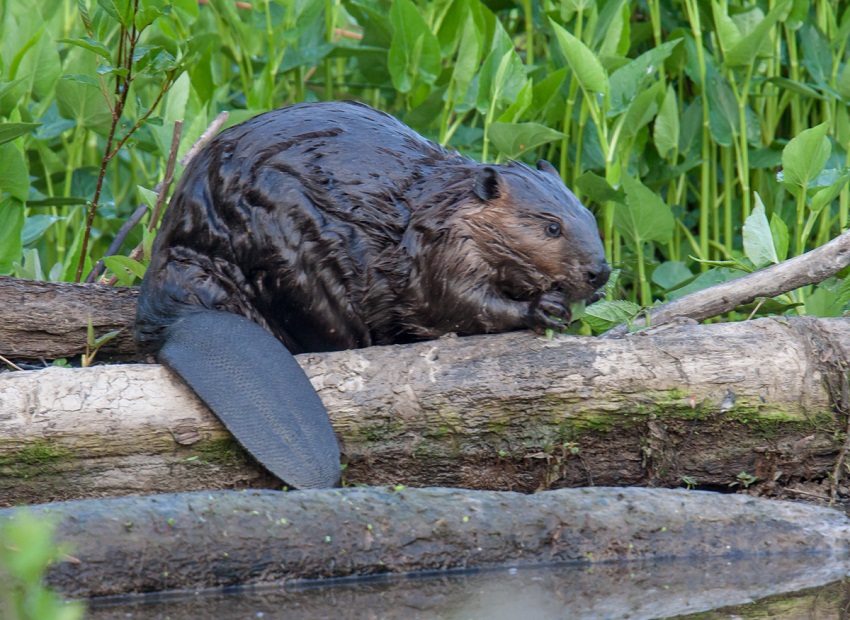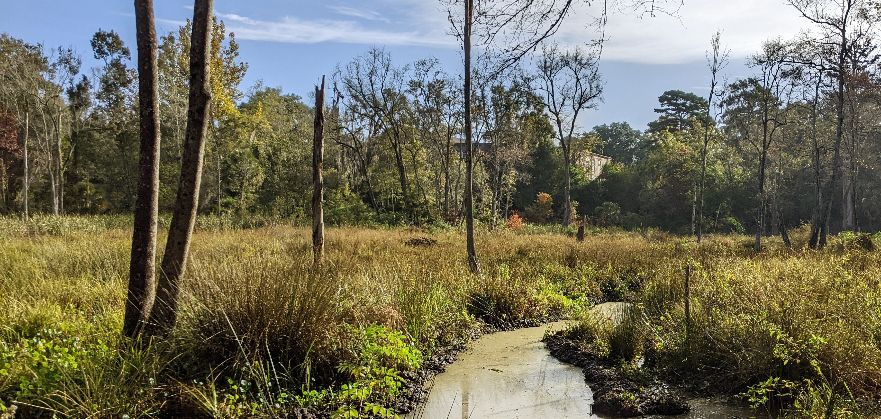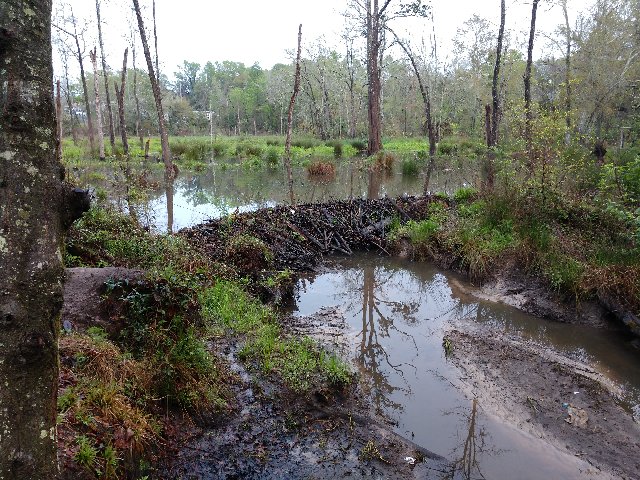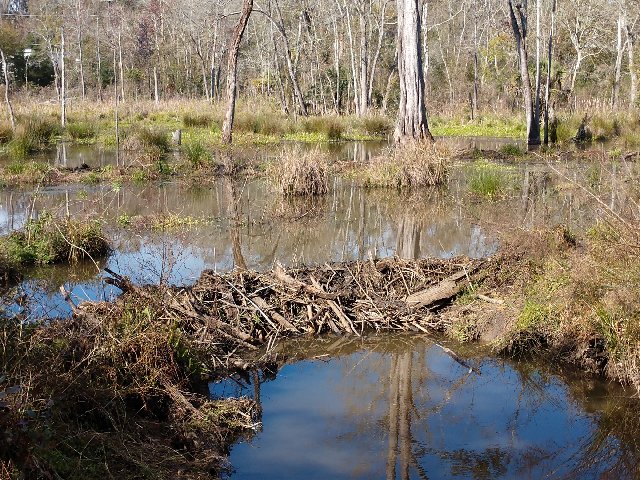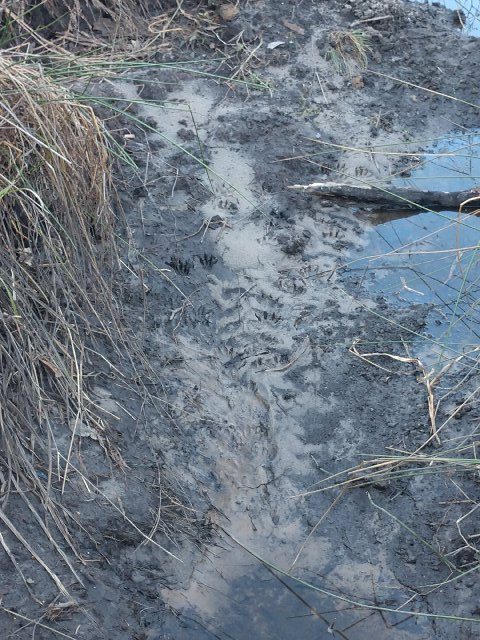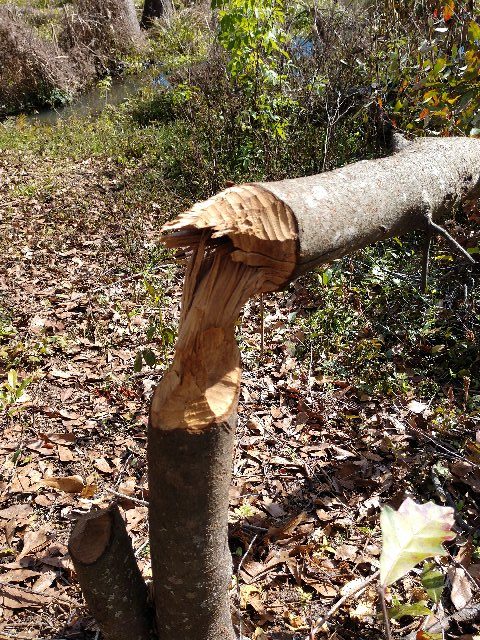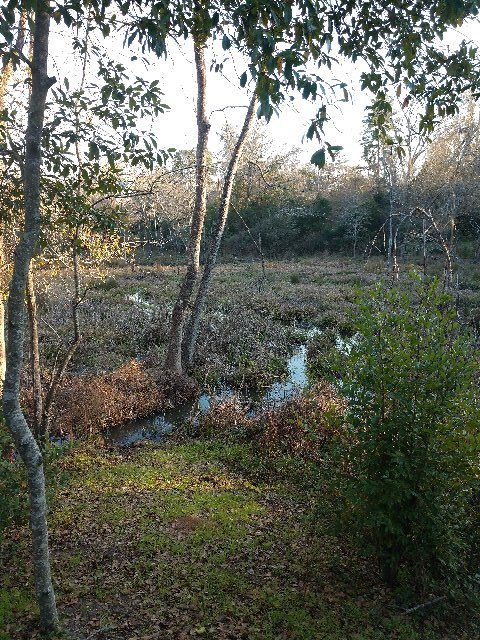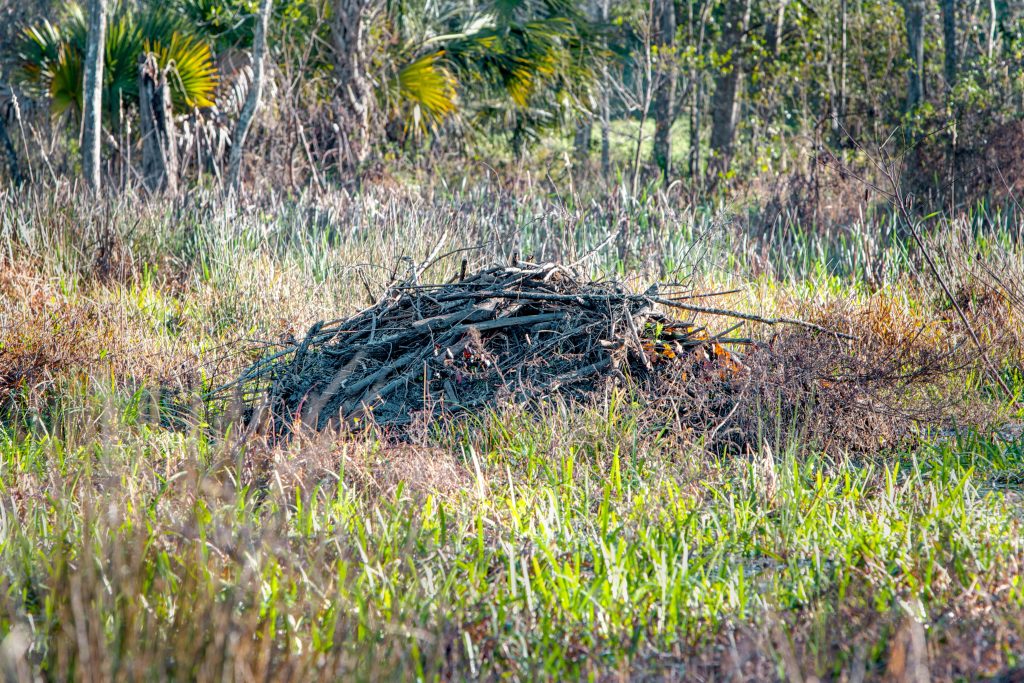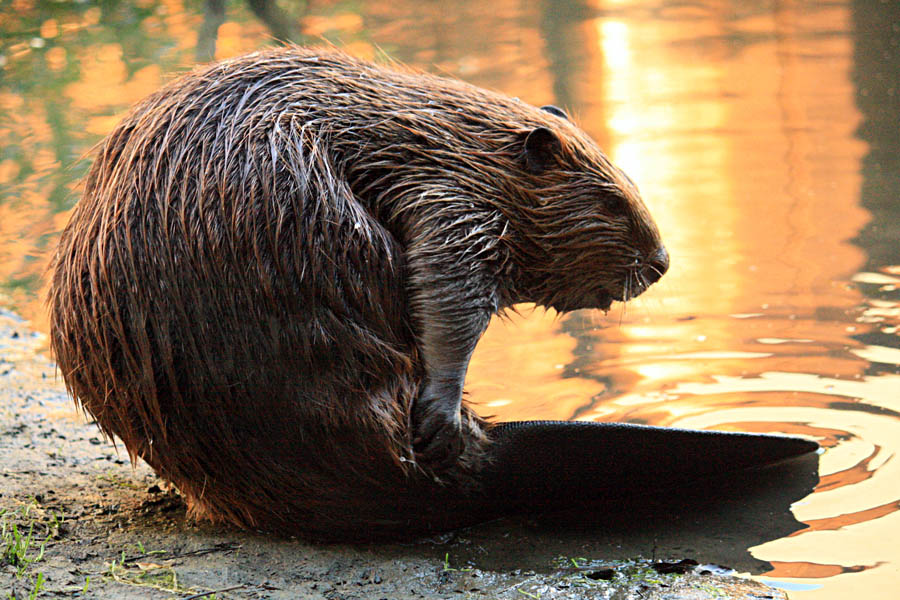by Gordon L. Magill
If you have lately wandered up to the wet marsh which lies between Chowkeebin Nene, East Indianhead Drive and Ostin Nene, you may have noticed that there is evidence of beavers living there. Walking along the south end of the marsh, you will likely have seen several dams built by the beavers, which hold back large pools of water that are two to three feet deep. You might have also looked out to the middle of the marsh and seen, surrounded by cattails and marsh grasses, the beaver’s dwelling, or “lodge” constructed of branches and mud rising above the marsh.
An aerial photo taken in 1957 of what was known as the “steep head” ravine at the head of the valley that encompasses Indianhead Acres shows the land sloping into a marshy basin of several acres, filled with grasses and young trees, and through which meanders a small stream. The photo does not show much evidence of water. The stream was fed in part by a perennial, or year-round underground spring and rain runoff, as it still is today.
Grant Gelhardt, a long-time resident of Indianhead, recalls that in the 1980s the marsh basin was dry enough that he could walk across it without getting his feet soaked.
For some years the marsh basin or “steep head” was a dumping ground for concrete and construction waste, possibly from nearby development along Apalachee Parkway. Remnants of this dumping can still be seen.
According to Grant, about fifteen or twenty years ago beavers began to appear in the marsh. Where they came from is unknown, but increasingly beavers are appearing in the ponds, sloughs, waterways, even storm water impound ponds of Tallahassee. Presumably a pair of beavers found their way up Indianhead Creek to the open, marshy area and began to build dams on the stream and a lodge. “This is something beavers do and probably has happened over the history of the steep head, but this is the first time since Indian Head was developed in the ’50s, that beavers have dammed up the area and converted it to a marsh,” Grant says. Whether the same pair inhabits the marsh today is unknown, but since beavers live up to twenty-four years, they may be the same pair, or the offspring of the first pair that moved into the marsh.
The appearance of beavers in our neighborhood is exciting to nature watchers and yet is a small part of a much larger story that is still evolving. The North American beaver (Castor canadensis) is thought to have migrated from northern Europe to North America by way of the Siberian Strait land bridge, traveling this route when much sea water was locked up in vast glaciers during the Late Cenozoic Ice Age at least 7 million years ago, and possibly up to 10 million years ago. The oldest beaver remains, two fossilized teeth, were found in Oregon, and are 7 million years old.
Before Europeans first came to North America, or around 1600 A.D., zoologists estimate that there were between 100 and 200 million beavers on the North American continent. These mammals, the largest rodent in North America, were everywhere, from the sub-arctic pine and birch regions of Canada to the arid plains and canyons of northern Mexico, from the temperate Atlantic coastal regions and the humid Southeast to the wet, foggy Pacific shores. Wherever beavers went, they created wetlands: bogs, ponds, large pools, even small lakes by damming whatever stream or river they found. These wetlands were, and are, highly important in the creation of habitat for fish, amphibians such as frogs, water birds, songbirds, raptors and mammalian wildlife of many kinds. As the North American beaver was trapped nearly to extinction, wetlands simply dried up in the absence of beaver damming activities. Wikipedia states that: “It has been estimated that 195,000 to 260,000 square kilometers of wetlands (or well over 100,000 square miles) in the U.S. were converted to dry land because of the loss of beaver.”
By 1900, just 300 years later , the North American beaver was almost extinct. Beginning in the early 1600s beavers were trapped by the tens of thousands a year by hunters, woodsmen, and in the West by “mountain men” for their marvelously thick, luxurious, almost water-proof fur and castoreum, the oil secreted by the beaver from a gland under its tail and with which the beaver grooms and waterproofs its fur. Beaver fur was made into winter hats and coats, gloves, and a kind of “felt” that was used to produce the famous “Beaver top hats” of the 18th and 19th centuries. The fur was exported to Europe, Russia, China, and other parts of the world. It was mainly a change in fashion styles away from products made with beaver fur that helped save the North American beaver from disappearing. In the late 1800s and early 1900s, restrictions were placed on the trapping of beavers by the US and Canadian governments. Today the population of North American beavers is estimated at 10 and possibly 15 million animals. This is still just a fraction of the historic population.
Our Indianhead beavers are probably of the sub-species C. c. carolinensis or Carolina beaver, which is found throughout the Southeastern states. As adults, they measure about two to three feet long, (including their long, flat, scaled tails,) and weigh around forty to fifty pounds. The male would be larger than the female. Beavers are primarily nocturnal, and active most of the night. By sunrise they are safely back inside their “lodge,” preparing for a long day’s snooze.
If you could watch the beavers under the full moon, or through an infrared camera lens or binoculars at night, you would see a lot of activity. The beavers would be swimming around, exercising, and gathering food, which includes tree branches, bark, twigs, leaves, and buds. They would also, in spring and summer, be munching on green aquatic plants such as water lilies and cattail rushes, which have tender shoots and roots. Beavers can eat many species of trees, including black cherry, red oak, aspen, birch, hornbeam, maple, sweetgum, and are especially fond of young willow. Most of these tree species are growing at the Indianhead marsh.
Beavers must constantly be gnawing on wood fiber, which wears down their four strong, thick front teeth or incisors, which are continually growing. The beaver can digest all this wood fiber and other vegetable material, called lignocellulose, because they are “hindgut digestors” whose caecum, or large blind pouch at the beginning of the large intestine or colon forms a fermenting factory inhabited by billions of microbacteria that help digest the lignocellulose in the wood and other vegetable fibers eaten by the beaver. The nutritional value of this food is high, and the beaver gets a lot of energy from it. Beavers store large caches of small trees and branches with leaves in the pond near their lodge and can get through the coldest winter of the northlands, swimming under ice from their lodge to their “wood pantry” to get fresh food.
With your night vision you would also see the beavers at work repairing or enlarging the dams that hold back water for their pond. Beavers are “hard-wired” to dam up running streams or plug the leaks in their dams. I have seen large holes in their dam at the Indianhead marsh following a heavy rain, and watched the water drain from the ponds into the stream below the dam. Within a few days, the damage is repaired, and the water level in the ponds rising back up to near the top of the dam. As Grant Gelhardt observes, “over the times the beavers have been here they have built several dams and several of them have washed away or have been breached but the water level in the marshlands has seemed to stabilize behind the beaver dam.”
To build a dam, beavers cut down small trees, gnaw off the branches, and drag or push the tree trunks and limbs downstream into a pile at a narrow place on the stream. With its dexterous front paws and powerful, webbed hind feet, the beaver then excavates mud from the stream bottom or banks to push into place on top of the brush, adding grasses, stems of rushes, and even rocks. The result is a solid structure that spans both sides of the stream, that backs up the stream’s flow, forming a pond.
There’s a solid reason for all this beaver industriousness: damming up a stream to make a pond or lake creates deeper water, and that means safety for the beaver from predators like wolves, coyotes, cougars, or humans. The beavers can now build their lodge out in the middle of the deeper water. The beaver lodge is built entirely of branches, sticks, mud, and grasses, similar to the dam. The lodge is partly underwater, partly above. It has a “floor” of branches, through which the beaver chews two entrances, one on each side of the lodge. The beaver thus has an escape route out if one side of the lodge is invaded by a predator. Mud pushed up into the lodge from the pond bottom helps support the “floor.” Above the “floor” are two platforms: one to dry out on, and one for sleeping.
When the beaver dives underwater to forage for food, to escape a predator, or to work, it can see clearly, due to a “nictitating,” or transparent membrane which covers its eyeball, and which underwater acts like a snorkeler’s mask. Beavers can swim and stay underwater for up to fifteen minutes, which may explain why you may never see a beaver break the water’s surface, unless you’re very patient. If you do see one, and then hear a loud “slap!” it means the beaver has seen or smelled you. The sound is made when the beaver slaps its large, flat tail on the water to sound a warning alarm. This tail is also a fat-storage larder, in which fat is reserved for the beaver’s energy needs in winter or when food is scarce.
As you look out over the marsh, you may notice openings in the marsh vegetation, filled with water, that meander about but lead back toward the beaver’s lodge. These are “canals” which the beavers use to access different parts of the marsh, to move branches and sticks through the water, and as a trail back to the lodge. Where these canals meet the marsh’s banks, there may be a muddy land trail where the beaver climbs out of the water. If you’re lucky and watchful, you may see where the beaver has left paw prints and marks from its tail.
Do beavers have babies? You bet, but they are called “kits.” Starting at about two or three years old, adult beavers will have one litter a year. The parents mate in the water during the winter months. About three months later, between two and six kits will be born in the lodge between May and June. The kits, weighing between eight to twenty-four ounces, can swim very soon after birth and will stay with their parents for up to two years. Beavers are monogamous, and can stay together for many years, having multiple litters. If one mate dies, the survivor will often leave its pond to seek a new mate. Sometimes this search ends badly, with a beaver being run over while crossing a road or becoming lost in a neighborhood or storm drain.
Some people have doubts about whether beavers contribute anything to a local environment. There are arguments that beavers remove too many trees, that they create too many ponds and wetlands, and that they carry diseases harmful to human and pets. Many zoological studies have shown that the North American beaver is a “keystone species.” A keystone species is an organism that has a very large impact on its natural environment relative to the organism’s population. By damming streams to make ponds and other wetlands, which in turn irrigate nearby forests, the beaver has an outsized impact on its environment, including creating new ecosystems.
As formerly dry land is flooded and wetlands emerge, aquatic plants can seed and grow, providing food for insects and birds. Trees such as willow and alder move in, which are good food sources for other insects. Soon, beaver ponds become habitat for reptiles and amphibians such as salamanders, water snakes, frogs, and turtles. Fish find deeper water in which to move into and thrive. The new wetlands attract ducks and large water birds, such as bitterns, herons, and cranes. Hawks such as osprey and eagles prey on the fish and amphibians, and make nests, as do owls. Other semi-aquatic mammals such as river otters, muskrats, ferrets, and minks also may soon inhabit beaver ponds and wetlands. The beaver dams act to slow water flow, reduce soil erosion, impound silt in the ponds or marsh behind the dam, and help reduce flooding.
Any hazard to humans or pets that beavers pose probably lies in the unlikely event that someone, or someone’s dog, may be bitten by a beaver. Severe bacterial infection could result from a bite. It is important to avoid trying to catch or handle a beaver, even a sick one. Avoid handling a dead beaver without gloves and a facemask. Beavers may be hosts to several ectoparasites and internal parasites including nematodes, trematodes, and coccidian intestinal parasites. Their stool or offal may contain Giardia lamblia, a pathogenic intestinal parasite that causes human giardiasis. At all costs, avoid drinking or ingesting water from a beaver pond or nearby stream, unless it is boiled for 15 minutes or put through a microbial water filter.
The beaver habitation of Indianhead marsh is worth protecting and preserving. As the beavers maintain large pools of water in the marsh, over time more and more animals and birds will visit or perhaps inhabit the marsh and trees around it. Even today a watchful visitor with binoculars, especially in early morning or late in the day may see wood ducks or mallard ducks, Canada geese, blue heron, night heron or green heron, white egrets or white ibis, red-shouldered hawks, kingfishers, and many species of songbirds. The marsh, its trees and plants, and the beavers that helped to create it, is a beautiful, living natural observatory of wildlife to study and enjoy just beyond our doorsteps.
